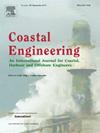澳大利亚海岸不同时间尺度上极端静水位趋势和年际变化的驱动因素和可预测性
IF 4.5
2区 工程技术
Q1 ENGINEERING, CIVIL
引用次数: 0
摘要
静止水位是指没有海面波浪的平滑水面基准面以上的高度,通常由港口的潮汐计测量。在本研究中,我们提出了一个改进的模型来预测非平稳极端静水位(ESWL),该模型既考虑了确定性的ESWL驱动成分,也考虑了概率成分,以考虑风暴事件的随机影响,使用了澳大利亚沿海76个潮汐计的30年记录(1990-2019)。模式的确定性表述代表了气候变化驱动的整体ESWL趋势的非平稳性,以及天文潮汐周期和ENSO变率对年际变率的个人贡献。模型的概率公式代表了剩余随机风暴潮发生的性质。我们的研究结果讨论了显著的ESWL趋势,包括背景平均海平面上升和不包括背景平均海平面上升。4.4年的月潮周期显著影响澳大利亚北部的ESWL变化。虽然La Niña在大多数站点提高了eswl,但澳大利亚东南部的许多站点未受影响。我们使用该模型来研究未来气候的高影响贡献,预计到本世纪末海平面将每年上升6毫米,ENSO将增加16%。我们的研究结果表明,海平面上升将主导其他驱动因素和预计的澳大利亚ENSO变率的增加。该模型能够进行更精确的预测,确定未来几十年ESWL影响的新阈值。在这方面,改进沿海建模工作可以为应对海平面上升的规划和适应措施提供信息。本文章由计算机程序翻译,如有差异,请以英文原文为准。
Drivers and predictability of extreme still water level trends and interannual variability along the coast of Australia across different time scales
Still water levels, representing the height above a datum of a smooth water surface without surface waves, are typically measured by tide gauges in ports. In this study, we present an improved model for predicting non-stationary extreme still water levels (ESWL), which accounts for both deterministic ESWL driver components and a probabilistic component to account for stochastic influence of storm events using 30-year records (1990–2019) from 76 tide gauges around the Australian coast. The deterministic formulation of the model represents the non-stationarity of the trends in the overall ESWL driven by climate change, along with the individual contribution to interannual variability made by astronomical tidal cycles and ENSO variability. The probabilistic formulation of model represents the nature of remaining stochastic storm surge occurrence.
Our findings discuss significant ESWL trends, with and without background mean sea level rise included. A 4.4-year lunar tidal cycle significantly affects ESWL variability in northern Australia. While La Niña raises ESWLs at most sites, many in southeastern Australia are unaffected.
We use the model to examine high impact future climate contributions, which project an additional six-mm/year sea level rise and a 16% increase in ENSO by the end of the century. Our results suggest that sea level rise will dominate the other drivers and the projected increase in ENSO variability across Australia.
This model enables more precise predictions, identifying emerging thresholds for ESWL impacts in the coming decades. Here, improved coastal modelling efforts can inform planning and adaptation measures in response to rising sea levels.
求助全文
通过发布文献求助,成功后即可免费获取论文全文。
去求助
来源期刊

Coastal Engineering
工程技术-工程:大洋
CiteScore
9.20
自引率
13.60%
发文量
0
审稿时长
3.5 months
期刊介绍:
Coastal Engineering is an international medium for coastal engineers and scientists. Combining practical applications with modern technological and scientific approaches, such as mathematical and numerical modelling, laboratory and field observations and experiments, it publishes fundamental studies as well as case studies on the following aspects of coastal, harbour and offshore engineering: waves, currents and sediment transport; coastal, estuarine and offshore morphology; technical and functional design of coastal and harbour structures; morphological and environmental impact of coastal, harbour and offshore structures.
 求助内容:
求助内容: 应助结果提醒方式:
应助结果提醒方式:


